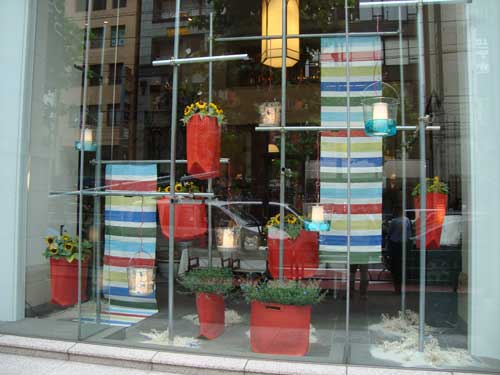
クリスマスローズという花は冬の終わりのしるしです。この植木鉢は、東高円寺のトンキという大好きなトンカツ店の外にありました。
This potted hellebore, pronounced kurisumasu rouzu in Japanese, looks super lush outside my favorite tonkatsu restaurant, Tonki in Higashi Koenji. These flowers signal the end of winter.
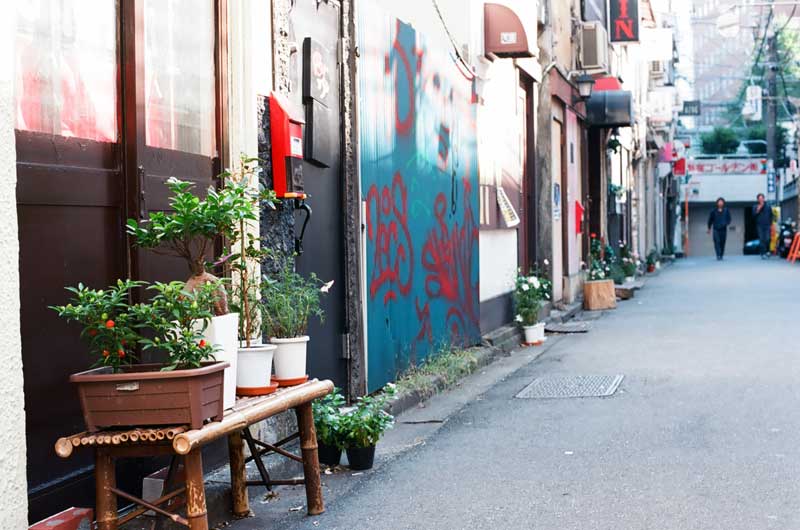
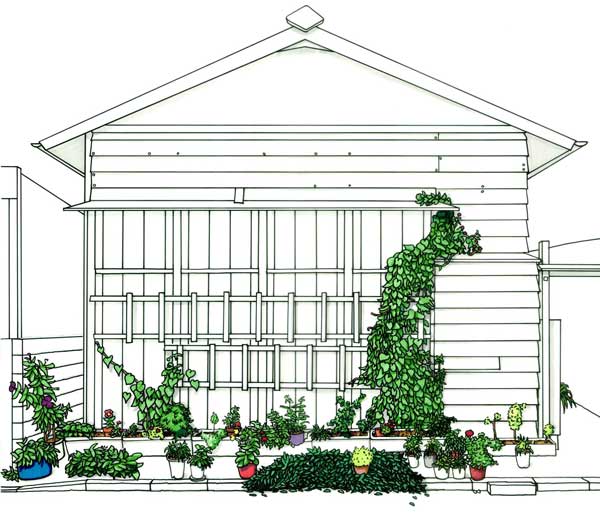
サイモン・パリッシュというイギリスのアーチストから、東京の植木鉢の庭の絵をいただきました。二十年前に東京に住んでいたそうですが、今でも東京の感じをよく覚えているんですね。
I was pleasantly surprised to hear from English artist Simon Parish, who shared with me (and my readers) his drawings of Tokyo potted plant gardens. I love his compositions, the contrast between the line drawings and the (hand-colored?) plants and pots, the mix of cultivated and semi-wild urban vegetation.
Simon explained that he lived in Tokyo about 20 years ago. I am super impressed with his current art work, and feels it evokes the types of Tokyo city gardens that this blog celebrates. Maybe, garden-wise, Tokyo does not change so much over the decades or even centuries.

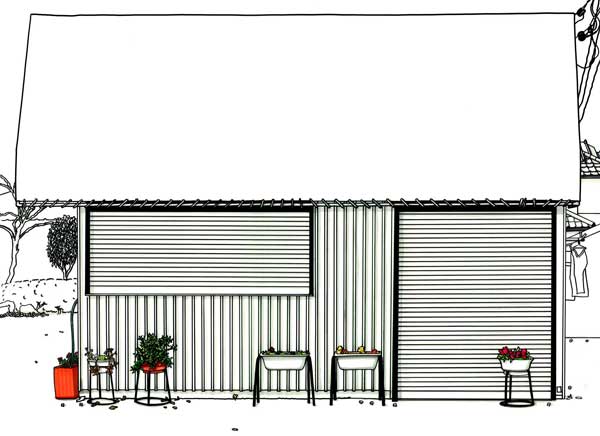
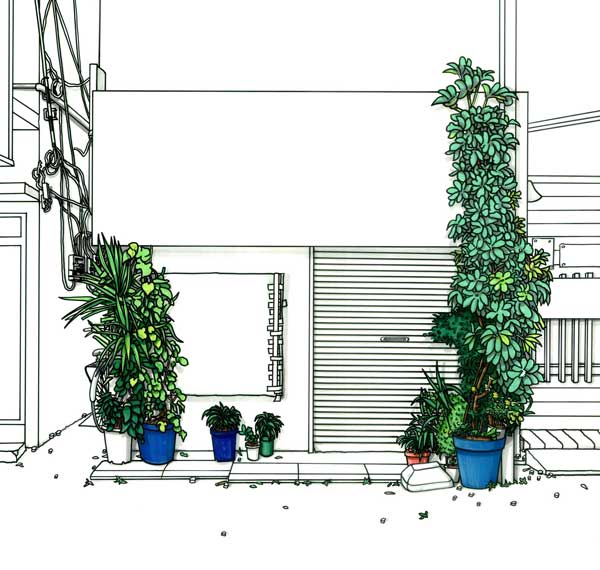
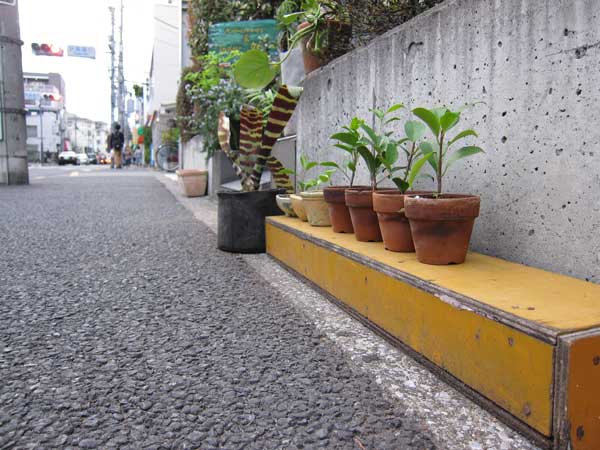
歩道で、この黄色の木箱は植物の素敵な舞台ですね。吉祥寺のEssenceというお店で。

I like how this very common and hardy camellia brings some life to a concrete patio in a Nakano back street. I wonder who placed it there and keeps it well pruned.
I can easily imagine a jungle growing between these older commercial buildings, a living food alley with scent and maybe a small creek bed. As it is now, this space between buildings functions as a giant chute for capturing rainwater, which then travels many kilometers and must be processed, alongside sewage, before being released into Tokyo Bay.
At least someone working or living there is decorating and enjoying the space.

This is the second year that I am growing this beautiful daisy-like cream flower with very soft leaves, Actinotus helianthi, known in Japan as “fairy white” (フェアリー・ワイト). I think it’s odd that a plant that is iconic of Sydney, Australia, where it is called Flannel plant, does so well in Tokyo. My San Francisco gardener friend Hank was amazed to see it in Tokyo. The Wikipedia page suggests it likes well drained soil, so perhaps it was destined to be a potted plant!

Walking at night, I noticed that this potted hydrangea is already leafing out, despite recent cold temperatures. It’s lovely to see this plant coming back to life for another season. It’s the mix of continuity and expectation that makes gardening so satisfying.
Location: Shinjuku ni-chome, outside of a small restaurant.
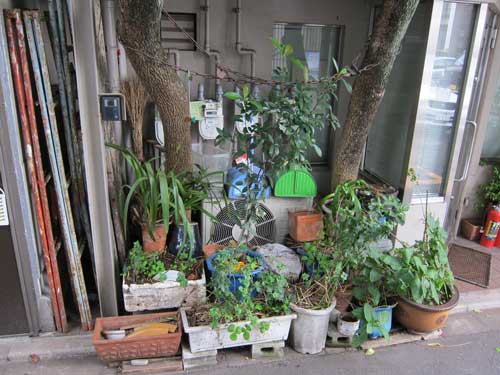
So many city dwellers think they have no space to grow anything. Recently I posted photos of a persimmon tree near my apartment that is three stories tall and full of fruit. I went back to take a shot of its trunk. Actually, it turns out that there are two trees growing in a space no bigger than the depth of an air conditioning unit. This small space provides sufficient soil to produce hundreds of fruit each year. There’s even room for ten potted plants spilling onto the street, a broom, and some ladders. The ability to create massive greenery and even food in such limited space always amazes me.
Update: A reader asked me to provide more context images for these persimmons growing in such a small spot. You can see below that they are growing in a tiny lane the width of one car, and that they reach out from their narrow bases to provide a tall canopy between the buildings. And there’s a third tree of the same size extending through the neighbor’s front cinderblock wall.
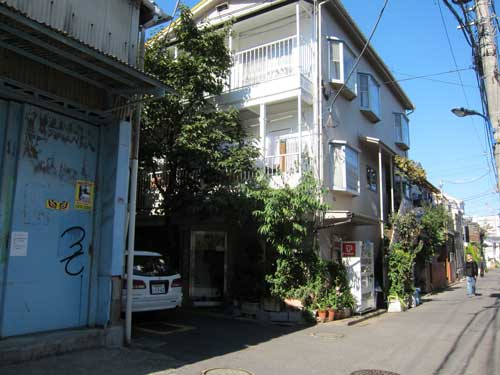
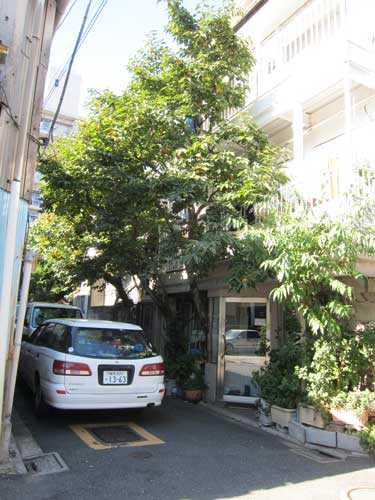
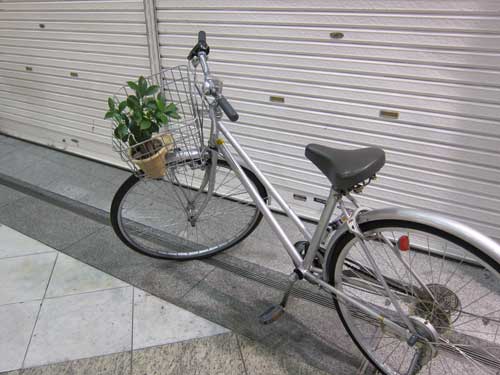
It’s awesome that someone has parked their bike illegally in Nakano’s Sun Mall after the shops have closed. Did the bicycle owner leave the potted plant in the basket, or did a stranger deposit it there? The city has a million stories, and this one combines two of my favorite city companions.

Walking down a large boulevard in Higashi Koenji, I was surprised to see these potted vegetables on the sidewalk. In addition to ginko trees, this street has many azaleas between the vehicle lanes and the pedestrian sidewalk. In this spot, there’s a semi-permanent row of pots. But these eggplants and tomatoes are an extra row that someone temporarily set up.

I love how seasonal and impromptu this vegetable gardening is. And, after almost two years in Japan, I am still startled that people can place plants they love on the street, and no one eats the vegetables, vandalizes, or steals the plants. A city that’s safe for vegetables and plants is one that also welcomes people.
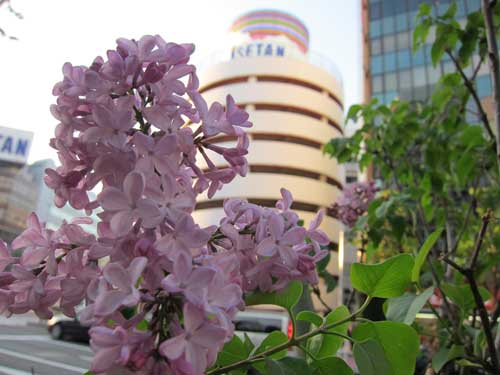
When I walk through Tokyo, I realize that the beauty of spring flowers, and plants in general, are increased by their juxtaposition with the built environment. There’s something about the context that makes urban nature more beautiful and more captivating.
Above are lilacs blooming on May 1 in Tokyo on Yasukuni Dori in Shinjuku, across the street from Isetan’s rainbow circular parking lot. Below are dogwood in full bloom in Higashi Koenji, with a 15 story apartment building behind the tree.
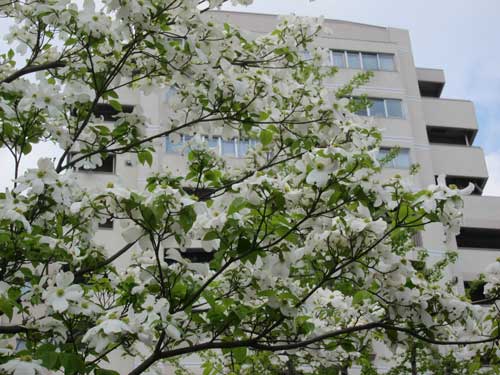
And at a different scale, there is the constant contrast between my potted balcony plants and the city that extends in every direction for as far as the eye can see.

The City of San Francisco has created a cool program encouraging people to adopt at San Francisco street tree for Christmas instead of purchasing a dead pine tree. City residents can choose between Southern Magnolia, Small Leaf Tristania, Strawberry Tree, and New Zealand Christmas Tree. For US$95 you can pick up a 2 meter potted tree in early December. The trees will be planted on San Francisco streets after the holiday, and adoptive families are invited to help.
This is a smart idea to eliminate the waste of traditional Christmas trees and to involve residents in a very personal way with the city’s goal of doubling its 110,000 street trees. The website has great links to learn more about the human benefits of urban trees, and the current and historical state of San Francisco’s urban forest.
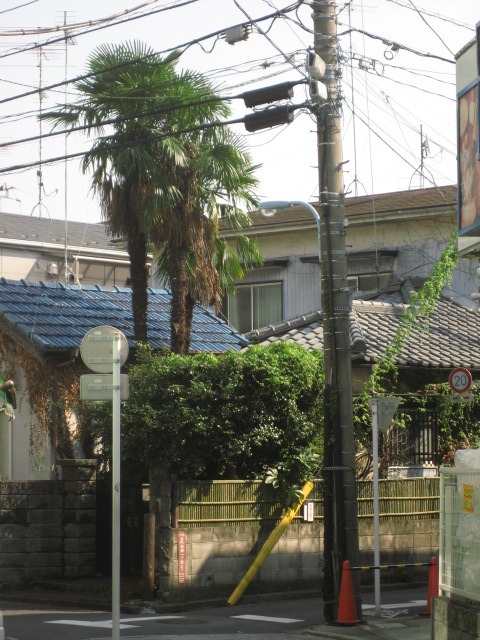
San Francisco palm expert Jason Dewees, of Flora Grubb Gardens, recently visited Tokyo, the Seto Inland Sea and Yakushima, and documented his horticultural findings on the International Palm Society’s travel forum. Together we created Palm Sundae several years ago in Northern California. Above is one of his photos.
Packed with photos, Jason’s post is an expert traveler’s guide to urban trees and plants with a palm focus, as well as Seto Inland Sea palms and exotic plants found on Yakushima, Japan’s wettest place whose high mountains feature ancient Cryptomeria trees (commonly called cedar in English and sugi in Japanese). In Tokyo, Jason identified two main types of palm trees: Trachycarpus fortunei, self-seeding in roadside plant beds, in small parks, as well as in the wooded areas of Meiji Jingu, and Tracheycarpus wagnerianus in residential gardens. Trachycarpus fortunei is known in Japanese as shuro (シュロ, 棕櫚), and has been used for many traditional crafts including paper making and brooms. Jason also discovered and photographed in Tokyo potted and in the ground Rhapis palms, both common and unusual.
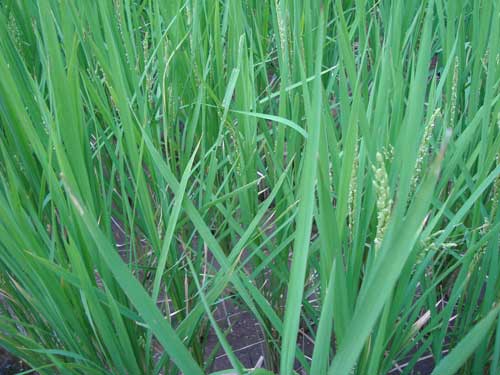
Yesterday I stopped by Ginza Farm to check on the rice. As you can see in the photo above, the rice seeds are already forming. Despite the challenges of growing rice in a high rise-district, as Iimura-san explained last month, the plants are thriving.
In fifteen minutes, I saw fifteen visitors, plus the attention of the construction workers next door. One visitor was a Ginza gallery worker, another a retiree and his wife, a chef, two smartly dressed young women, and a young guy taking photos of the ducks. Clearly, Ginza Farm has become a neighborhood treasure, with repeat visitors checking on the progress of this urban farm.
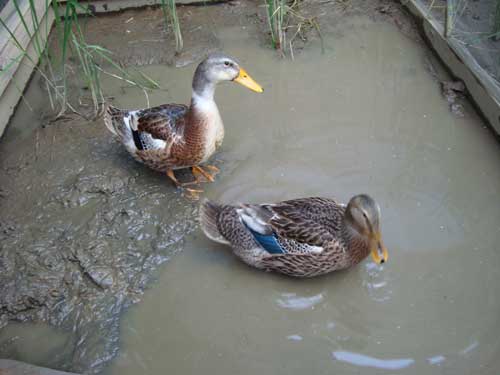
Born on July 3, the ducks have become almost full grown in just over two months. They have gone from cute yellow ducklings to mature, striped fowl. The sign in front of them explains that they are an integral part of the rice farming, in a method called aigamo nouhou (あいがも農法). Ducks that are a cross-breed that includes wild duck eat weeds and insects in the rice paddy, and provide fertilizer with their droppings. This natural method reduces pesticide, insecticide, and fertilizer, and has been introduced throughout Asia. Aigamo nouhou rice farming was used in pre-Edo Japan, and was recently revived in the 1990s.
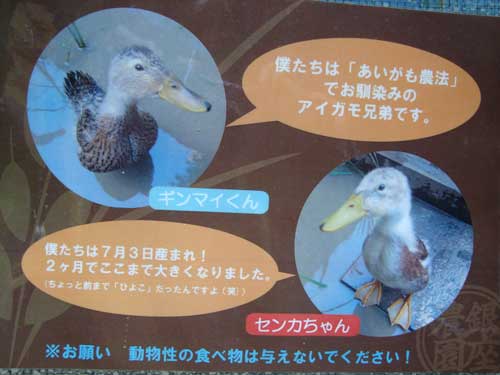
I am amazed at how well Ginza Farm attracts the neighbors’ attention, how well they communicate their commitment to natural farming, and how they combine attractive design with environmental education. In addition to the well crafted wood logs that forms the paddy and provides seating and tables, there are flowering morning glories, potted pine trees, bamboo, hostas, and wind chimes as decoration.
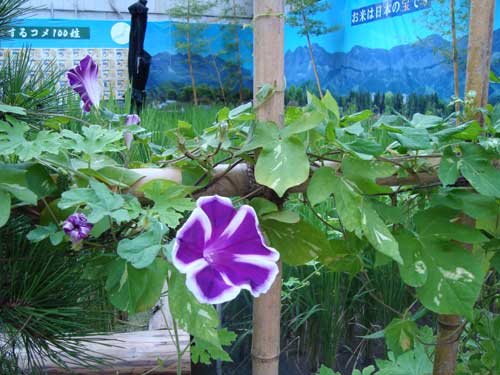
For more information on Japan-Bangladesh duck-rice farming cooperation and science, please see Hossain, Sugimoto, Ahmed, Islam, “Effect of Integrated Rice–Duck Farming on Rice Yield, Farm Productivity, and Rice–Provisioning Ability of Farmers,” Asian Journal of Agriculture and Development, Vol 2, No 1, 2005, pp 79-86.

U Goto Florist in Roppongi is one of Tokyo’s oldest and most luxurious flower shops. The tray above is a stunning summer arrangement of bamboo fireflies, cactus candles and sand. Founded in 1892 and owned by the third generation of the same family, U Goto prides itself on being Western-style and employs three European flower designers trained in Dutch and French flower academies.
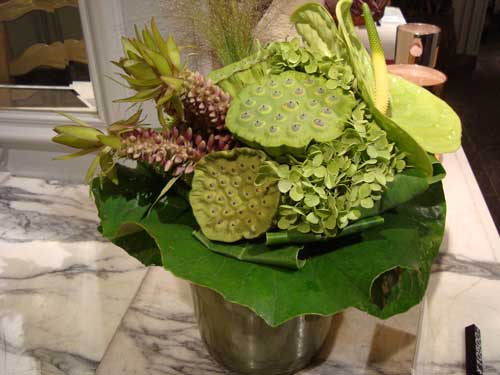
Housed in a 1990s company-owned office building near Roppongi Crossing, U Goto is Western- style in a way that only Japanese could perfect. Multi-roomed and multi-layered, the high ceilinged shop includes cut flowers, fake flowers, and potted plants, and also offers flower-arranging classes. Some examples of unusual arrangements and bamboo framing were on display. The shop fittings– stone floors, marble work tables, distressed cabinets, an excess of crown molding that is still somehow rustic chic– evoke Manhattan or Paris.
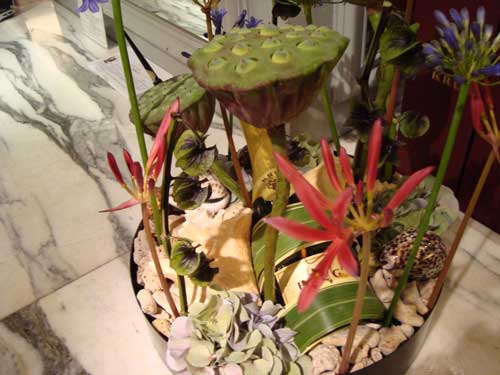
I was charmed that the staff offered me a demi-tasse of coffee, which gave me the opportunity to carefully observe them arranging and wrapping lavish bouquets of roses, dahlias, sunflowers and orchids in the finest papers. Orchid petals were carefully protected in cloth paper wrappings.
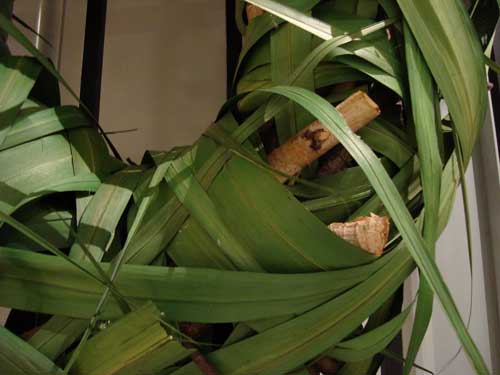
U Goto’s extremely high standards necessitate removing all flowers and plants that are even slightly past peak. Cut flowers are donated to hospitals, and plants to senior centers. The summer window display below would be replaced after the Obon holiday with a fall display, in spite of the continued heat and humidity. One designer was already thinking forward to the Christmas display.
